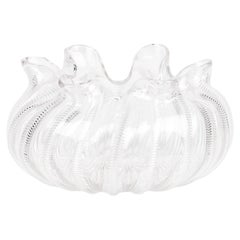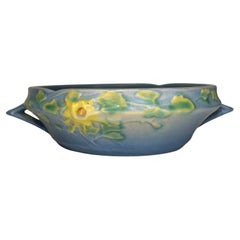Stevens & Williams Bowls and Baskets
Acclaimed for exceptional and exquisite decorative glass vases, crystal serveware and other ornamental objets d’art, glassmaker Stevens & Williams was at the forefront of British glass design from the 19th to early 20th centuries.
Though the company began to take shape in 1776, Stevens & Williams Ltd. was formally established in 1847 in Brierley Hill in the West Midlands of England by entrepreneurs William Stevens and Samuel Cox Williams. During this period and into the late 19th century, demand was high for attractive, mass-produced glass, with imports providing strong competition for British glassmakers. Determined to produce glass products that were “a cut above the rest,” Stevens & Williams focused on creating unique and innovative glassware of unparalleled quality.
Led by master glassmaker John Northwood, Stevens & Williams became known in the 1870s for its hallmark colored glass. In 1880, the company garnered more attention when Northwood encouraged 17-year-old Frederick Carder to join the firm as a draftsman and designer. Despite Carder’s young age, Northwood recognized his prodigious talent for cameo work, engraving, cutting and intaglio, skills which would contribute to some of Stevens & Williams’ most beautiful glass and crystal pieces.
Toward the turn of the century, Stevens & Williams expanded from a traditional Victorian style to include elements of Japonisme and Art Nouveau, styles that particularly influenced Carder.
Northwood continued to work for the company until his death in 1902. A year later, Carder left for the United States, where he became famous for cofounding Steuben Glass Works in Corning, New York.
Stevens & Williams had considerable success in the early 20th century. In 1919, King George V awarded the firm its first Royal Warrant. In the 1930s, it was renowned for its Art Deco-style centerpieces, barware and other glass pieces. Stevens & Williams continued production until 1967. In 1968, the company’s name was changed to Royal Brierley Crystal.
Today, Stevens & Williams’ legacy lives on as one of England’s most revered glassmakers. Glass and crystal bearing the Stevens & Williams mark continue to be highly prized by collectors around the world.
On 1stDibs, discover a range of antique and vintage Stevens & Williams decanters, serveware and glass and decorative objects.
1880s English Aesthetic Movement Antique Stevens & Williams Bowls and Baskets
Crystal
Late 20th Century Irish Modern Stevens & Williams Bowls and Baskets
Crystal
Early 20th Century American Stevens & Williams Bowls and Baskets
Clay
1890s English Victorian Antique Stevens & Williams Bowls and Baskets
Silver, Sterling Silver
2010s Mexican Stevens & Williams Bowls and Baskets
Glass
Late 19th Century English Aesthetic Movement Antique Stevens & Williams Bowls and Baskets
Crystal
Mid-20th Century Italian Mid-Century Modern Stevens & Williams Bowls and Baskets
Gold Leaf
1980s Swedish Mid-Century Modern Vintage Stevens & Williams Bowls and Baskets
Glass, Art Glass, Blown Glass
Late 19th Century French Aesthetic Movement Antique Stevens & Williams Bowls and Baskets
Bronze
Late 19th Century English Aesthetic Movement Antique Stevens & Williams Bowls and Baskets
Ceramic
1880s British Late Victorian Antique Stevens & Williams Bowls and Baskets
Glass
19th Century English Art Nouveau Antique Stevens & Williams Bowls and Baskets
Crystal
Late 19th Century French Aesthetic Movement Antique Stevens & Williams Bowls and Baskets
Bronze
Stevens & Williams bowls and baskets for sale on 1stDibs.
- 1stDibs ExpertJanuary 10, 2025Opinions may differ as to what Steven Brown's most famous painting is. However, he is widely known for his colorful depictions of animals. Some of his most popular prints among collectors include Heather McCoo, Allan & Jackie McZoo, Forest Of Argyle, Home and Save the Ocean Families. Shop a diverse assortment of art on 1stDibs.
- Who was William Plunkett?1 Answer1stDibs ExpertApril 5, 2022William Plunkett was a furniture designer whose work combined sculptural flair with engineering precision in the 1950s and 1960s. Plunkett contributed to post-war British design, and his pieces are still in high demand today. Shop a collection of vintage and modern William Plunkett furniture on 1stDibs.
- Was William Blake a Surrealist?1 Answer1stDibs ExpertNovember 20, 2024No, William Blake is not usually considered a Surrealist by art historians. Although his paintings, prints and poetry exploring the realm of the unconscious mind influenced the Surrealist movement that started in 1924, his work predates it and was part of 19th-century Romanticism. Some of his most famous artworks include The Ancient of Days, The Ghost of Fleas, Pity, Newton and The Great Red Dragon and the Woman Clothed with the Sun. On 1stDibs, explore a collection of Surrealist art.
- Why was William Morris famous?1 Answer1stDibs ExpertAugust 8, 2024William Morris was famous for his work as an artist. He was well-known for creating beautiful floral-patterned paintings that were turned into textiles and wallpaper. In addition, Morris designed furniture and helped define the Arts and Crafts movement. Also a writer, he penned several books, including News from Nowhere and The Earthly Paradise. Find a range of William Morris art and furniture on 1stDibs.
- 1stDibs ExpertMay 30, 2024William Morris was famous for his work as a designer. During the Victorian era, his intricate floral prints appeared on wallpaper and textiles and set interior design trends. Morris' work helped define the Arts and Crafts Movement. He was also a mathematician and a well-known poet. On 1stDibs, find a variety of William Morris pieces.
- What was William Morris' style?1 Answer1stDibs ExpertFebruary 13, 2024William Morris's style was Arts and Crafts. In fact, the designer was responsible for helping to define and develop the style. The history of Arts and Crafts design has roots in 1860s England, with an emphasis on natural motifs and simple flourishes. Morris became known for reviving historical techniques such as embroidery and printed fabrics in his furnishings and influenced American Arts and Crafts designers like Gustav Stickley. Shop a selection of William Morris furniture on 1stDibs.
- 1stDibs ExpertJanuary 19, 2025Kyffin Williams is famous for his artistic achievements. He was born near Llangefni in Wales, and the local parishes, farmland and the stone walls that defined his earliest experiences would later inform his drawings and paintings. Some of his most notable works include The Way to the Cottages; Mynydd Bodafon, Anglesey; Cottage in the Fields and Waterfall, Ogwen. Shop a range of Kyffin Williams art on 1stDibs.
- 1stDibs ExpertAugust 8, 2024Opinions vary as to what William Morris's most famous piece is. However, art historians generally agree that the British designer's intricate floral motifs were a landmark in 19th-century design. Some contenders for the title of "most famous" work by Morris include the decorative patterns Lodden, Branch, Four Fruits, Marigold, Chrysanthemum and Larkspur. Explore a selection of William Morris art on 1stDibs.
- 1stDibs ExpertApril 5, 2022Yes. William Morris is one of the most prolific textile designers, and was the founder of the Arts and Crafts movement of the late 1800s. His designs incorporated elaborate floral motifs of silk and linen embroidery. On 1stDibs, shop a selection of items with William Morris’ iconic designs from some of the top sellers around the world.
- 1stDibs ExpertMarch 22, 2022William Spratling's model and inspiration was pre-Columbian decorative objects. For example, he patterned the Quetzalcoatl brooch off the details of a heart bowl found in the collection of the Museo Nacional de Antropología in Mexico City, Mexico. On 1stDibs, shop a selection of William Spratling jewelry and decorative objects.
- 1stDibs ExpertApril 5, 2022Yes, William Morris made furniture. While William Morris is best known for being a textile designer, poet and artist, he also designed furniture. William Morris’s furniture was inspired by nature and his belief in socialism, with designs focused on creating affordable and long-lasting furniture that everyone could enjoy. Shop a selection of William Morris furniture on 1stDibs.
- 1stDibs ExpertApril 5, 2022Yes, William Morris made some tapestries. William Morris was a true artisan and delved into a variety of different areas. He’s also credited with ushering in the Arts and Crafts movement in England. He held a lot of respect for those who could produce tapestries and made his first one in 1879. He learned more and created more tapestries but also established a small tapestry workshop where he employed tapestry weavers. Shop a collection of tapestries from some of the world’s top sellers on 1stDibs.
- 1stDibs ExpertApril 5, 2022William Morris used a variety of fabrics to produce wallpaper, floor coverings and other textiles. However, cotton and linen were the most common materials. His workshop became known for producing intricate hand-blocked prints on textiles. Find a variety of William Morris rugs and textiles on 1stDibs.
- 1stDibs ExpertFebruary 7, 2024Which William Morris designs are the most famous is open for debate. However, some patterns of William Morris wallpaper have consistently remained in style since their debut in the 19th century. They include Larkspur, Jasmine, Marigold, Wreath, Willow Boughs, Acanthus, Strawberry Thief and Chrysanthemum. On 1stDibs, shop a collection of William Morris furniture and decorative objects.
- 1stDibs ExpertJanuary 19, 2025William-Adolphe Bouguereau is famous for his artwork. During the 19th century, he was a leading French academic painter and supporter of the Salon. He remains best known for the way he depicted women, both in classically inspired works like Nymphs and Satyr and The Birth of Venus and romantic portraits like The Bohemian and The Young Shepherdess. On 1stDibs, shop a selection of William-Adolphe Bouguereau art.
- 1stDibs ExpertMarch 13, 2024The story of what happened to Mitchell Gold + Bob Williams is one of financial difficulties. In August 2023, the furniture maker closed its factories due to bankruptcy. However, Surya purchased the company in November 2023 and announced plans to reopen the factory and resume production of Mitchell Gold + Bob Williams pieces. Shop a collection of Mitchell Gold + Bob Williams furniture on 1stDibs.
- 1stDibs ExpertOctober 30, 2024How much William Hoffman paintings are worth varies based on size, condition and other factors. In 2000, five years after the artist's death, his painting Moonlit Seascape sold for $3,300 at a gallery in Santa Fe, New Mexico. A self-taught artist, Hoffman produced mainly seascapes early in his career but focused more on depicting the landscapes of his native Montana and other areas of the Western United States later in life. For assistance valuing a Hoffman painter, consider consulting a certified appraiser or experienced art dealer. Explore a diverse assortment of paintings on 1stDibs.
- 1stDibs ExpertOctober 24, 2024How much William Hodges paintings are worth will depend on their size, condition, historical significance and other characteristics. At an auction in 2019, his Matavie Bay in the Island of Otaheite set a record for the artist's work when it sold for more than $848,000. The piece depicts a landscape that the British artist experienced firsthand as a part of James Cook's second voyage to the Pacific Ocean in the 1770s. Hodges produced a series of paintings inspired by his voyages and later reproduced select works as prints. If you own a piece by Hodges, you can use the services of a certified appraiser or knowledgeable art dealer to find out how much it may be worth. Find a wide range of landscape paintings on 1stDibs.


